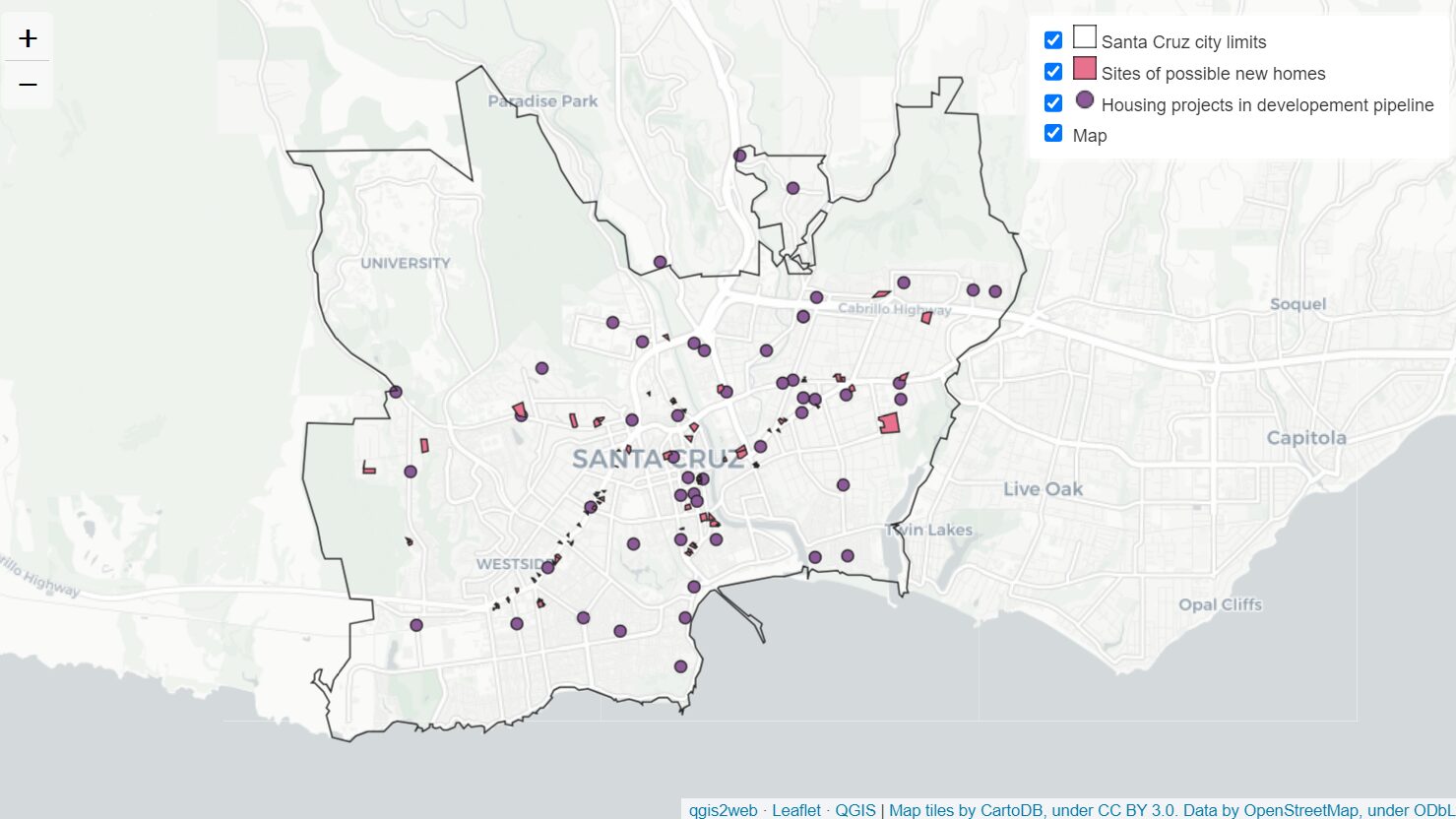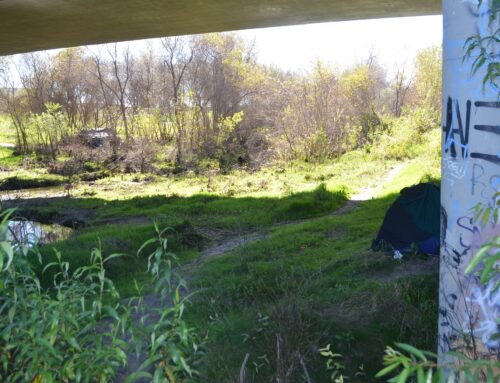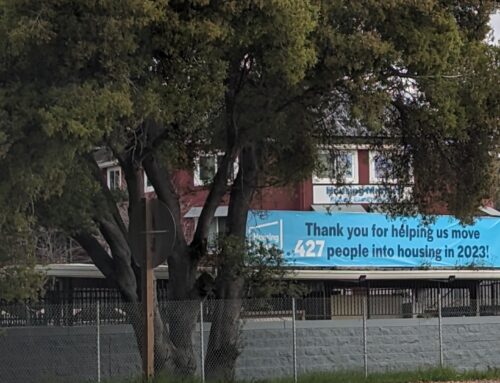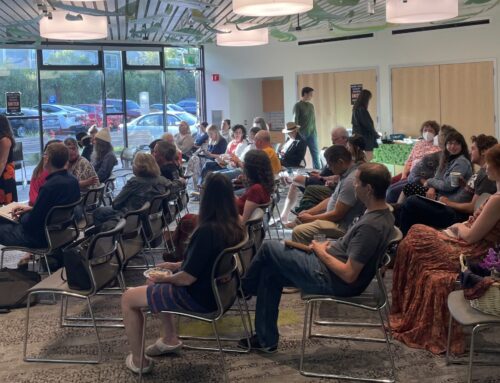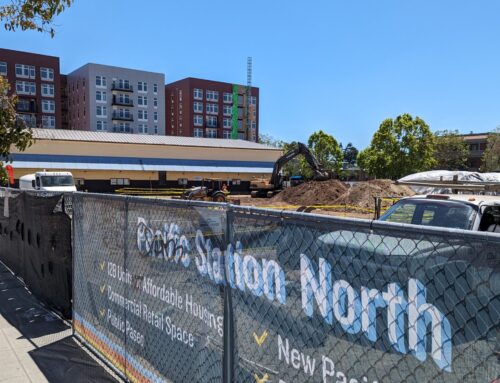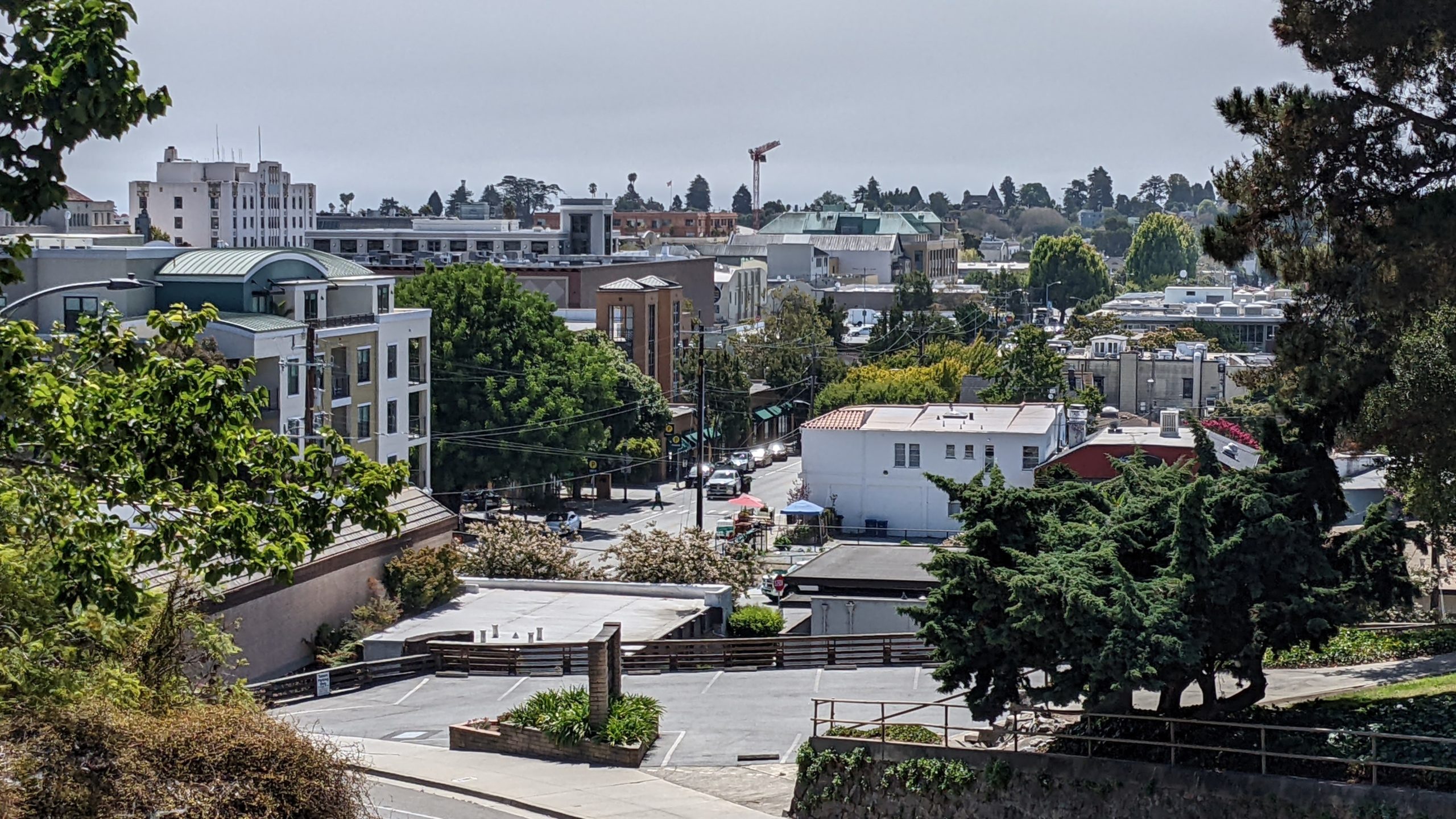
A crane at a housing project is visible across downtown Santa Cruz in January 2023. (Stephen Baxter — Santa Cruz Local file)
SANTA CRUZ >> The Santa Cruz City Council on Tuesday approved a final Housing Element of the city’s General Plan that meets state-mandated housing goals and envisions denser multifamily housing downtown and along major roads such as Soquel Avenue and Water, River and Ocean streets.
Santa Cruz must build nearly 4,000 new homes over the next eight years to meet state targets. More than half of those homes could come from projects that developers already have proposed. The Housing Element also includes about 100 places where developers could propose to build about 2,300 new homes.
- The Housing Element includes a list of places where developers could build housing and a detailed list of policies and programs to support more affordable housing.
- Not every property in the Housing Element will be developed, and some properties not on the list could also host new housing, said Lee Butler, Santa Cruz’s director of planning and regional development.
- Affordable housing projects on public land, such as Pacific Station South and the Downtown library, housing and garage project, will help the city meet housing goals, Butler said. City leaders plan to pursue similar projects on other city properties such as 125 Coral St.
- State officials did not allow hundreds of planned UC Santa Cruz dorms to count towards the city’s housing plan.
Santa Cruz city leaders submitted five drafts to the California Department of Housing and Community Development before state officials signaled that they would sign off on the plan. At Tuesday’s meeting, city council members said the adopted Housing Element would help continue the city’s progress toward state targets.
“I think that’s really great work that we’ve done,” said Santa Cruz City Councilmember Scott Newsome. “And I think this document will help us continue that work.”
Click for an interactive map. Based on Santa Cruz’s adopted Housing Element, a map shows where housing projects are being developed in purple and sites of potential new homes in pink. The map does not include UC Santa Cruz planned developments which are not part of the Housing Element. (Map by Jesse Kathan, data from City of Santa Cruz)
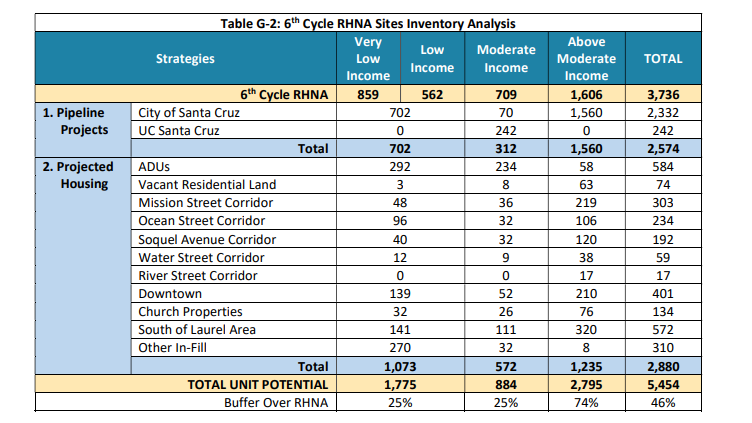
Santa Cruz’s adopted Housing Element identifies about 2,600 homes in development. It also includes 2,296 potential new homes at about 100 sites. There are 548 potential new ADUs, or accessory dwelling units, without specified locations. (City of Santa Cruz)
The state requires all local governments in Santa Cruz County to have a state-approved Housing Element by Dec. 31.
Capitola, Scotts Valley, Santa Cruz County and Watsonville are set to miss that deadline, leaders said this week.
Other cities’ Housing Elements
As Capitola, Scotts Valley, Watsonville and Santa Cruz County wait on state approval, they could be subject to state laws that allow unfettered housing development with little to no local control.
After Dec. 31, a government without an approved plan is considered out of compliance with state law. If local governments don’t have a state-certified Housing Element, they are subject to the Builder’s Remedy. It compels city or county leaders to approve any housing development with at least 20% affordable homes until they have an approved Housing Element. The developments can be taller or denser than local limits. Developers in Santa Monica and other cities have used the law to push through housing projects that would have otherwise been unlikely to be approved.
- Watsonville has not submitted any draft Housing Elements. The city is required to post a draft plan for a 30-day public review before submitting it for a 90-day state review. In October, Watsonville adopted a separate plan to add denser and taller housing developments downtown. The Builder’s Remedy is “not a huge concern,” said Watsonville Principal Planner Matt Orbach. “We welcome development within the city,” he said. “I don’t think someone’s going to come in and propose a 15-story, 20-story skyscraper. I just don’t think this market supports that.” The city plans to publish a draft for public review in December or early January, Orbach said.
- Scotts Valley leaders submitted multiple drafts of its Housing Element, but the plan has not been approved by state authorities. The Scotts Valley City Council is scheduled to vote Dec. 20 on whether to submit the next draft to the state. State authorities will have 60 days to approve the plan or request more changes.
- Capitola leaders adopted the sixth draft of its Housing Element Nov. 6. State officials have until Jan. 14 to approve the plan or request further changes. The state has “told us that they’re going to try to complete that before the end of the year,” said Katie Herlihy, Capitola’s community development director.
- Santa Cruz County Supervisors adopted the latest draft of the county’s Housing Element Nov. 14. The plan is under a 60-day state review.
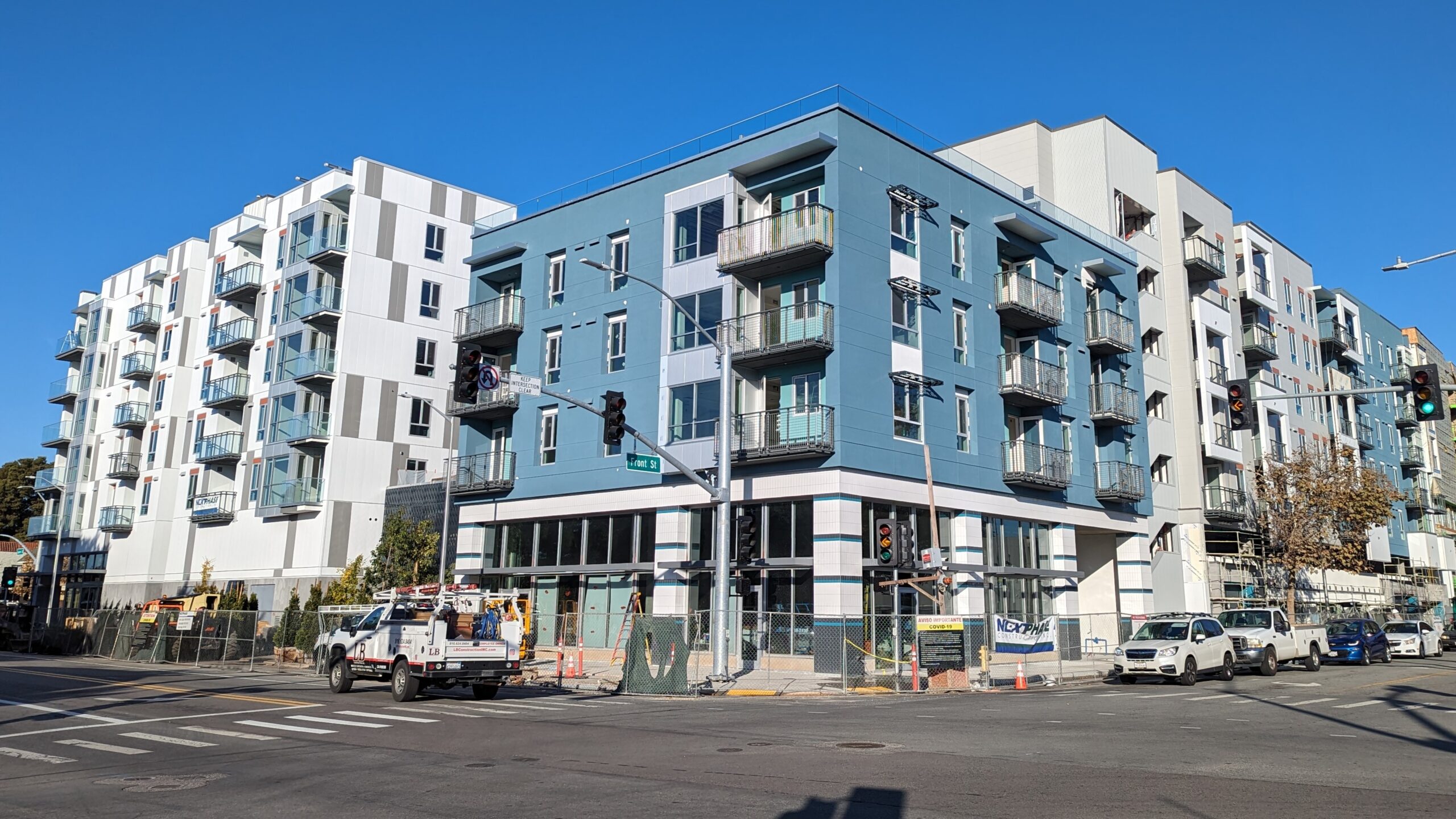
Anton Pacific Apartments, a 207-unit market-rate housing project at Front and Laurel streets in Santa Cruz, is expected to open in late February. Lease information is on the developer’s website. (Stephen Baxter — Santa Cruz Local)
Santa Cruz Housing Element
The Association of Monterey Bay Area Governments, or AMBAG, sets goals for jurisdictions within Santa Cruz and Monterey counties. In October 2022, AMBAG adopted a plan that mandates the City of Santa Cruz to allow for 3,736 new homes, more than five times the previous target.
The City of Santa Cruz was one of 6% of local governments in the state that met the state’s prior housing production targets. Santa Cruz’s success was partly because of changes to the Downtown Plan in 2017 that allowed for taller buildings downtown, said Santa Cruz Principal Planner Matt VanHua.
“We went from four or five stories in our downtown to seven stories,” said VanHua said in an interview. “The market responded very positively.” City staff also streamlined approval of affordable housing. That made the city more competitive for state grants to build housing on city land and facilitated money lending to private developers who include affordable housing, Butler said.
Butler added that the adopted Housing Element should help usher in new housing.
“This plan is really going to help us lay the foundation for a more sustainable and more equitable future for Santa Cruz for many decades to come,” Butler said in an interview. “This is a really big accomplishment.”
Councilmember Sandy Brown said some groups she spoke with were concerned about “a lack of urgency” in addressing the needs of low-income tenants. “I do hope that the lack of inclusion in this Housing Element does not mean that we won’t be talking about those ways we can be supportive moving forward,” Brown said.
Santa Cruz resident Candace Brown said during the meeting that the city should rezone industrial areas to allow more workforce housing and student housing. She said the council should prioritize efforts to promote homeownership. “It took me 18 years to save up to buy a home,” she said.
Housing advocates said the plan would help the city produce more homes.
“I for one am looking forward to seeing all of the goals that we are setting up this evening implemented,” said Rafa Sonnenfeld, policy director at the state group YIMBY Action and member of Santa Cruz YIMBY.
“There’s going to be political challenges, I’m sure, to get it done. But I just thank this council for taking the initiative to make the commitment,” Sonnenfeld said.
Correction: A previous version of this story misstated the number of sites and potential new homes in the Santa Cruz Housing Element.
Questions or comments? Email [email protected]. Santa Cruz Local is supported by members, major donors, sponsors and grants for the general support of our newsroom. Our news judgments are made independently and not on the basis of donor support. Learn more about Santa Cruz Local and how we are funded.
Jesse Kathan is a staff reporter for Santa Cruz Local through the California Local News Fellowship. They hold a master's degree in science communications from UC Santa Cruz.


